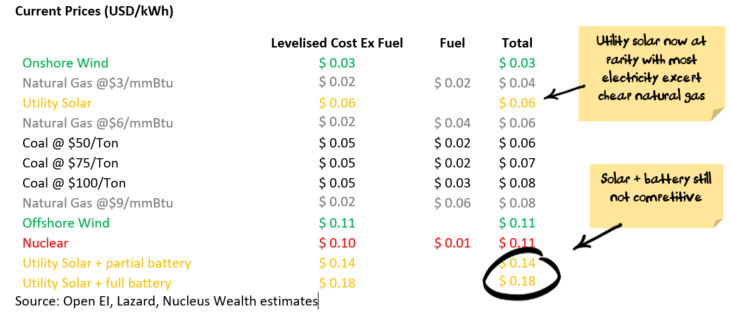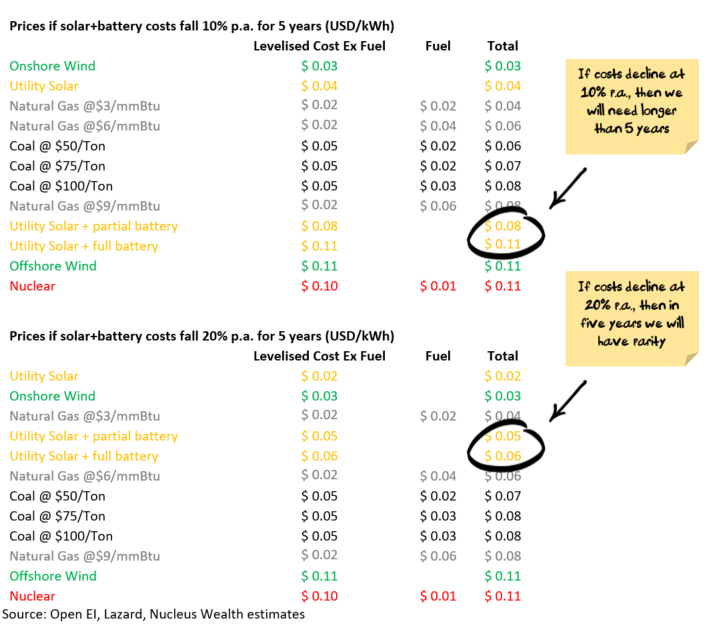Energy pariah, South Australia, is, in fact, Australia’s energy leader:
Tesla founder Elon Musk’s plan for a giant battery for South Australia is billed as the world’s biggest – but if Lyon Group’s David Green has his way Tesla’s system won’t even be the biggest in SA.
The parallel battery plans could turn the state’s energy crisis into a strength by setting South Australia up as the global grid battery hub with three of the world’s most powerful grid storage systems within its borders or nearby.
Tesla’s triumph in the tender to build a big battery system to help lower prices and stabilise South Australia’s blackout-prone power grid has clarified Lyon’s plans, Mr Green said, and the Brisbane-based group will probably increase the size of the giant battery it is preparing to roll out in the state’s Riverland rather than trim its size.
Lyon aims to start construction in October and have the 100 megawatt battery, which is being built with a 330MW solar farm in the sundrenched district, ready in the first quarter of next year.
…ZENEnergy chairman Ross Garnaut, said…”The big battery and the market and systems integration that ZEN developed over the last 20 months would have a large positive effect in stabilising SA electricity supply,” he said.
“It would increase competition in the wholesale energy market leading to lower overall electricity prices. To have beaten us in a competitive process, the Tesla project must be even better.
“Over the next few weeks, ZEN will assess whether there is still room in the SA market for our own Port Augusta battery based grid energy solution.”
Meanwhile, in Australia’s mostly coal-driven driven power state, QLD:
Wholesale electricity prices in Queensland have been the most expensive in the National Energy Market for most of this year as its state-owned generators more than doubled the dividends it paid to the debt-riven Palaszczuk Labor government.
After the Queensland government last month ordered its largest generator to pursue less profit following growing industry pressure, a federal government analysis shows wholesale prices in Queensland have been on average 30 per cent higher than other states in the National Energy Market.
Federal Energy Minister Josh Frydenberg said the analysis also showed Queensland had almost double the number of spot-price spikes above $5000 per megawatt hour of any other state in recent years.
According to the analysis, wholesale electricity prices hit $5000/MWh in Queensland 30 times, compared with 16 times in South Australia, 10 times in NSW, and twice in Victoria since mid-2014.
“The reason for this is that generators in Queensland have been gaming the system,’’ Mr Frydenberg writes in The Australian today.
With gas prices where they are, solar and battery are more competitive. Within five years they’ll be more competitive than coal even before the world hits it with a carbon price. I have greatly simplified all of these figures to illustrate the point. There is lots of debate about the exact levels for all of these prices because the calculation is not that simple, and the region or country influences the numbers. I have generally used the most recent reasonable price that I could find and where various numbers existed I took the lower price for all technologies.

Utility Solar at 6c is now in front of coal, and in front of natural gas at Australian and Asian prices. Natural gas is still cheaper in the US.
You will note that natural gas plants are cheaper than coal, but more sensitive to the price of natural gas than coal plants are to the cost of coal.
It also shows why the current high prices in Australia for natural gas are sowing the seeds for its own demise.
The battery prices shown here are for shifting solar in particular. This is not the same as the current energy crisis in South Australia – that is a matter of smoothing intermittent sources and has different economics. Gas peaking plants (which are used for intermittent power) run at about $0.20-$0.30 per kWh and the battery costs above would be higher for intermittent use. Most recent large-scale studies have shown that batteries are cost effective for the grid at the margin to smooth the peaks and troughs, but not for widespread adoption. The 100-day Tesla batteries would have the same profile.
There is a range of different outcomes we could see for prices.
Two base case scenarios are solar+battery costs fall at 10% per year for the next five years, another at 20%.
In the last 5 years costs have fallen around 20% per year. Given how low solar costs are, the more important assumption is battery prices.

SA is the only state in the country investing predominantly in Australia’s energy future.

